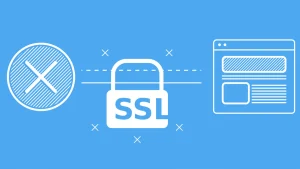Does SSL Alone Guarantee Website Security?
Many website administrators, upon installing an SSL (Secure Sockets Layer) certificate, tend to believe that seeing the green padlock in the browser’s address bar means their website is now 100% secure and immune to cyber threats. While this belief underscores the certificate’s importance, it’s an inaccurate and potentially dangerous assumption. Installing SSL is merely the first step on a long road to achieving comprehensive website security.
The core question is: What exactly does SSL cover, and what are its limitations? The answer is key to understanding the necessity of employing supplementary security layers.

What Is SSL and What Does It Do?
SSL, which is mostly referred to as TLS (Transport Layer Security) today, is an encryption protocol. Its primary function is to establish a secure, encrypted communication channel between the user’s browser and the hosting web server.
This encryption ensures that sensitive data, such as login information, credit card details, or contact forms, cannot be eavesdropped upon or tampered with during transit. SSL’s effect—the green padlock and HTTPS indicator—significantly boosts initial user trust and sends a positive signal to search engines like Google.
The Role of SSL in SEO
Today, having SSL is not just a security measure; it is a critical Ranking Factor for Google. Browsers flag sites without a certificate as “Not Secure,” which directly harms the User Experience (UX) and consequently impacts the site’s SEO performance. Therefore, although SSL doesn’t protect the site from internal attacks, its absence means complete elimination from competition in search results.
Which Parts of Website Security Does SSL Cover Alone?
When we talk about website security with SSL, we are specifically referring to security at the data transport layer:
- Encrypting User Data (Preventing Eavesdropping): This is SSL’s most crucial function. If a party tries to intercept the data being sent or received (Wiretapping), they will only obtain a meaningless, encrypted data string.
- Preventing Man-in-the-Middle (MITM) Attacks: By verifying the server’s identity through the certificate, SSL ensures the user is indeed connected to the authentic website server, not a malicious server intending to spy.
- Initial Browser and User Trust: The green padlock signals to the user that the connection is secure. This feature is vital for websites handling financial transactions.
SSL’s Limitations in Ensuring Website Security
The SSL protocol focuses on encryption and is not a tool for detecting or repelling direct attacks on the website or server. Consequently, SSL’s limitations in protecting the core website or server are significant:
- No Protection Against Hacking Attacks (SQL Injection, XSS, etc.): SSL cannot stop attacks that exploit vulnerabilities in code, forms, or outdated plugins. A successful SQL Injection, even over a perfectly encrypted connection, can compromise the database.
- No Protection Against Malware and Botnets: If the server or website becomes infected with malware or connected to a botnet, SSL plays no role in detecting, removing, or preventing these infections.
- No Prevention of Server Intrusion Due to Weak Configuration: A weak password for the server administration panel or an unnecessary open port are weaknesses that SSL does not cover. SSL does not prevent server intrusion resulting from incorrect configuration.
- SSL Does Not Stop DDoS or Brute Force Attacks: Distributed Denial-of-Service (DDoS) attacks or repetitive attempts to guess a password (Brute Force) occur at the network or application layer, and SSL is not designed to counter them.

Essential Measures to Supplement Security
To achieve genuine website security, a multi-layered defense approach must be adopted. Is SSL sufficient? Absolutely not. Alongside SSL, the following vital measures must be taken:
Server Hardening and Secure Configuration
The infrastructure layer, the hosting server, is the foundation of website security. An insecure server, even with SSL, is inherently vulnerable. Server Hardening involves a set of measures at the operating system and server software level aimed at reducing the Attack Surface. These specialized steps include disabling unnecessary services, configuring correct file and directory permissions, and using strong encryption algorithms for SSH and FTP. To ensure this security level in the infrastructure, choosing a hosting option that emphasizes security, such as providers offering a high-security and high-quality VPS, is a reliable starting point.
Combating Coding Flaws and Malicious Traffic (WAF & Headers)
- Using Hardware and Software Firewalls (WAF): A Web Application Firewall (WAF) analyzes incoming traffic to block known application attacks like SQL Injection and XSS before they reach the website, effectively preventing many hacking attempts.
- The Necessity of Implementing HTTP Security Headers: These Headers (like CSP) instruct the user’s browser on how to manage website content and prevent common client-side attacks—a task that SSL alone cannot cover and is vital for website security.
Managing Application and Infrastructure Vulnerabilities (Updates & Backups)
- Updating CMS and Plugins: Many intrusions occur due to the use of outdated and vulnerable versions of Content Management Systems (CMS) or their plugins. Regular updates are the first line of defense against software exploits.
- Regular Backup Creation: Creating regular, restorable backups is the best defense against successful ransomware attacks, human errors, or server crashes.
- Selecting Suitable Infrastructure: For large projects requiring full control, high-quality infrastructure is essential. In these scenarios, the option to Buy a dedicated server for website hosting can provide the flexibility and power needed to implement complex security layers.

Active Monitoring and Intrusion Detection (IDS/IPS)
Intrusion Detection Systems (IDS) and Intrusion Prevention Systems (IPS) constantly monitor network traffic and server activities. These systems issue warnings or even block malicious activity if they detect any suspicious patterns (like a high volume of login requests). This active monitoring provides a crucial and essential layer beyond the capabilities of an SSL certificate.
Logical Vulnerabilities and SSL Ineffectiveness
The greatest limitation of encryption protocols like SSL/TLS is their inability to identify or prevent Business Logic Flaws. These vulnerabilities occur not in the coding nor in the transport layer, but in the way the website executes its business processes. For example, if an e-commerce site allows a user to apply a discount code multiple times by manipulating URL parameters, this is a logical flaw. SSL encrypts all communication, but the encrypted data includes the same repeated, illegitimate discount request, and the protocol cannot determine that the request is commercially incorrect. Detecting and fixing these types of vulnerabilities requires detailed application process review and specific security testing (Penetration Testing).
Is SSL Sufficient for E-commerce and Corporate Websites?
Due to the volume and sensitivity of data, e-commerce and corporate websites require significantly more security layers than a personal blog.
- Need for Commercial SSL (EV, OV): These sites typically use Organizational Validation (OV) or Extended Validation (EV) certificates in addition to simple SSL (DV), which include verification of the website owner’s identity.
- Need for Multiple Security Layers: For online stores handling card payments, adherence to standards like PCI-DSS and 24/7 security monitoring is unavoidable. Also, secure infrastructure offers greater reliability.
- Real-World Example: E-commerce vs. Personal Blog: A personal blog is mostly exposed to simple defacement attacks, but an e-commerce store is exposed to financial attacks, phishing, and customer data theft, which clearly highlights SSL’s limitations in this area.
Conclusion
SSL is an immensely important and necessary protocol, but it must be viewed in its proper context: SSL is important, but it is only one layer of website security.
This certificate merely places a secure lock on the “entryway” (the data transport layer) of the website. To protect the “house itself” (the server and website code) from thieves (hackers), you need complementary measures like a firewall, continuous updates, server Hardening, and, above all, a powerful hosting infrastructure. True website security requires a combination of SSL + secure server + supplemental security measures.





